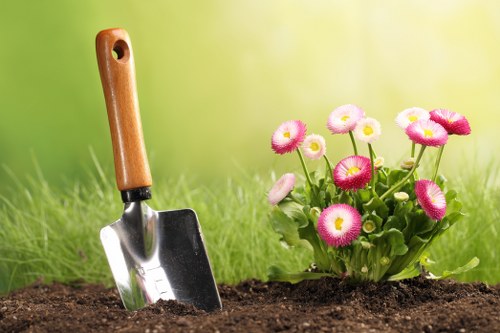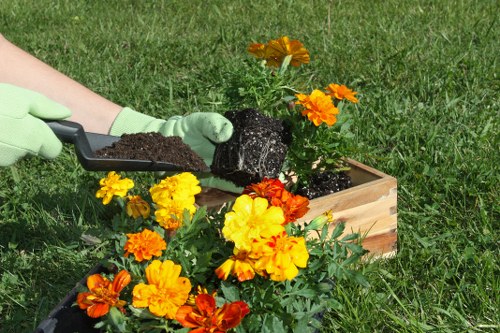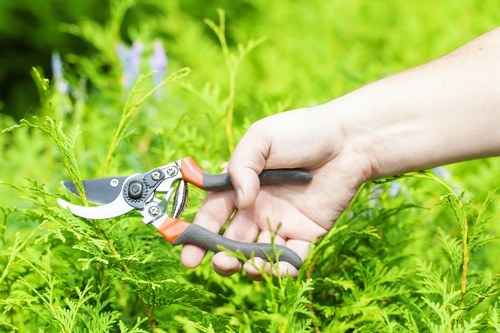Hedge Trimming in Southgate
Introduction to Hedge Trimming

Hedge trimming is an essential aspect of maintaining a beautiful and well-kept garden. In Southgate, where the climate and local flora present unique challenges, proper hedge maintenance ensures that your greenery remains healthy and aesthetically pleasing throughout the year.
Whether you’re a homeowner looking to enhance your property's curb appeal or a business aiming to create a welcoming environment, understanding the fundamentals of hedge trimming can make a significant difference. This comprehensive guide explores the various aspects of hedge trimming in Southgate, providing you with the knowledge needed to keep your hedges in top shape.
From choosing the right tools to mastering different trimming techniques, we cover everything you need to know to achieve professional-looking results. Let’s delve into the world of hedge trimming and discover how you can transform your outdoor spaces.
Benefits of Regular Hedge Trimming

Regular hedge trimming offers numerous benefits beyond mere aesthetics. It promotes the health and longevity of your plants by removing dead or diseased branches, allowing for better air circulation and light penetration. This preventive maintenance reduces the risk of pests and diseases, ensuring that your hedges remain robust and vibrant.
Moreover, well-trimmed hedges can define property boundaries, enhancing privacy and security. They create a structured and organized look, contributing to the overall appeal of your garden or business premises. Additionally, maintaining your hedges can increase property value, making it a worthwhile investment.
In Southgate, where the growing conditions can vary, regular trimming is particularly important to adapt to seasonal changes and local environmental factors. By keeping up with hedge maintenance, you ensure that your plants thrive year-round.
Choosing the Right Tools for Hedge Trimming

Selecting the appropriate tools is crucial for effective hedge trimming. The right equipment not only makes the job easier but also ensures precise and clean cuts, which are vital for the health of your hedges. Here are some essential tools you should consider:
- Pruning Shears: Ideal for tackling small branches and intricate shapes.
- Hedge Trimmers: Perfect for larger hedges, providing a uniform cut.
- Loppers: Suitable for thicker branches that regular shears can’t handle.
- Pole Pruners: Allow you to reach higher areas without the need for ladders.
- Protective Gear: Safety glasses, gloves, and sturdy footwear to protect yourself while trimming.
Investing in high-quality tools can significantly impact the efficiency and outcome of your hedge trimming efforts. Regular maintenance of these tools, such as sharpening blades and cleaning after use, will extend their lifespan and ensure optimal performance.
Understanding Different Trimming Techniques

There are various trimming techniques that cater to different types of hedges and desired shapes. Understanding these methods will help you achieve the best results for your specific plants:
- Shearing: This method involves using hedge trimmers to create a flat, uniform surface. It’s ideal for formal hedges and topiaries.
- Selective Pruning: Focuses on removing specific branches to promote healthy growth and maintain natural shapes. Suitable for informal hedges.
- Rejuvenation Pruning: Involves cutting back the entire hedge to encourage new growth from the base. Best for overgrown or neglected hedges.
- Thinning: Removes entire branches to increase light and air flow without altering the overall shape significantly.
Each technique serves a unique purpose and can be applied based on the type of hedge and the desired appearance. Combining different methods may sometimes be necessary to achieve the perfect balance between form and function.
Best Times to Trim Your Hedges

Timing is a critical factor in hedge trimming. Trimming at the right time ensures that your hedges recover quickly and maintain their shape and health. In Southgate, the optimal times for hedge trimming typically fall in late winter or early spring, and again in late summer.
- Late Winter/Early Spring: Before the new growth begins, this is the best time to perform structural trimming and shape your hedges.
- Late Summer: After the main growth period, a lighter trim can help maintain the shape and prevent the hedges from becoming too dense.
- Avoid Trimming in Late Fall and Winter: Cold temperatures and potential frost can stress the plants, making them more susceptible to damage.
Additionally, it’s important to consider the specific needs of the hedge species you are maintaining. Some plants may have unique trimming requirements, so consulting with a local gardening expert can provide tailored advice.
Common Mistakes to Avoid
While hedge trimming can enhance the beauty of your garden, certain mistakes can lead to poor results and harm your plants. Here are some common pitfalls to watch out for:
- Over-Trimming: Cutting too much at once can shock the plants, leading to stress and reduced growth.
- Incorrect Timing: Trimming at the wrong time can impede the natural growth cycle and make the hedges more vulnerable to diseases.
- Using Dull Tools: Blunt blades can cause ragged cuts, increasing the risk of infections and slowing down recovery.
- Neglecting Regular Maintenance: Infrequent trimming can result in uneven growth and make it harder to maintain the desired shape.
- Ignoring Plant-Specific Needs: Different species have varied trimming requirements; failing to cater to these can negatively impact their health.
By being aware of these common mistakes, you can ensure that your hedge trimming efforts are effective and beneficial to your plants. Strive for a balanced approach that supports both the aesthetic and health aspects of your hedges.
Hiring Professional Hedge Trimming Services in Southgate
While DIY hedge trimming is feasible for small projects, hiring professional services in Southgate can offer numerous advantages, especially for larger or more complex tasks. Professional gardeners have the expertise, experience, and equipment to deliver high-quality results efficiently.
- Expertise: Professionals understand the specific needs of different hedge species and can apply the most suitable trimming techniques.
- Time-Saving: Outsourcing the task frees up your time, allowing you to focus on other aspects of garden maintenance or personal activities.
- Safety: Professionals are trained to handle tools safely and are equipped to manage high or hard-to-reach areas without risking injury.
- Consistency: Regular professional trimming ensures that your hedges maintain a consistent shape and healthy appearance year-round.
When selecting a hedge trimming service in Southgate, consider factors such as experience, customer reviews, range of services offered, and pricing. A reputable service provider will work with you to understand your specific requirements and tailor their approach accordingly.
DIY Hedge Trimming Tips
If you prefer to take on hedge trimming yourself, here are some tips to help you achieve the best results:
- Plan Ahead: Determine the desired shape and size of your hedges before you begin trimming.
- Use the Right Tools: Ensure your tools are sharp, clean, and suitable for the task at hand.
- Trim Gradually: Make small cuts over time rather than trying to achieve the final shape in one session.
- Maintain Balance: Aim for symmetrical trimming to keep the hedges looking even and well-proportioned.
- Dispose Properly: Remove all trimmed branches and debris to prevent pests and diseases.
Additionally, educating yourself about the specific requirements of your hedge species will enhance your ability to maintain them effectively. Consider consulting gardening books, online resources, or local experts to expand your knowledge.
Choosing the Right Hedge for Your Southgate Garden
Selecting the appropriate hedge plant is fundamental to successful hedge trimming and overall garden health. In Southgate, the climate supports a variety of hedge species, each with its own characteristics and maintenance needs. Here are some popular options:
- Boxwood: Known for its dense, evergreen foliage, boxwood is ideal for formal hedges and topiaries. It responds well to frequent trimming.
- Privet: A fast-growing deciduous shrub that forms a thick barrier, privet is excellent for privacy hedges.
- Laurel: With large, glossy leaves, laurel makes a striking, dense hedge that provides excellent coverage.
- Yew: A versatile evergreen that tolerates heavy pruning, making it suitable for both formal and informal hedges.
- Holly: Offers both beauty and functionality with its spiky leaves and bright berries, suitable for mixed hedges.
Choosing the right hedge depends on factors such as growth rate, foliage type, and the level of maintenance you’re willing to commit to. Consulting with local nurseries or gardening experts can help you select the best hedge for your specific needs and preferences.
Seasonal Care for Your Hedges
Maintaining healthy hedges requires attention to seasonal changes. Each season presents unique challenges and opportunities for hedge care in Southgate:
- Spring: Focus on pruning new growth and addressing any winter damage. This is also the time to fertilize and apply any necessary treatments to prevent diseases.
- Summer: Monitor for pests and ensure adequate watering, especially during dry spells. Light trimming can help maintain shape and encourage airflow.
- Autumn: Prepare your hedges for winter by cleaning up fallen leaves and performing a final trim to shape the hedges before dormancy.
- Winter: Protect your hedges from extreme cold and snow. Minimal trimming is needed unless to remove dead or diseased branches.
By adapting your hedge maintenance routine to the seasons, you ensure that your plants remain healthy and resilient against the varying weather conditions in Southgate.
Sustainable Hedge Trimming Practices
Adopting sustainable practices in hedge trimming not only benefits the environment but also contributes to the long-term health of your garden. Here are some eco-friendly tips:
- Use Manual Tools: Whenever possible, opt for manual hedge trimmers to reduce energy consumption and minimize noise pollution.
- Compost Clippings: Recycle trimmed branches and leaves by composting them, which enriches the soil and reduces waste.
- Choose Native Species: Native hedges are adapted to the local climate and require fewer resources to maintain.
- Water Wisely: Implement efficient watering practices, such as drip irrigation, to conserve water and support sustainable gardening.
- Minimize Chemicals: Use natural pest control methods and fertilizers to protect beneficial insects and maintain soil health.
Embracing sustainable hedge trimming practices ensures that your garden remains a thriving, environmentally friendly space for years to come.
Enhancing Curb Appeal with Well-Trimmed Hedges
Well-maintained hedges significantly enhance the curb appeal of any property. In Southgate, where neighborhood standards often emphasize neat and attractive gardens, a properly trimmed hedge can make a lasting impression. Here’s how to leverage hedge trimming to boost your property’s appearance:
- Define Boundaries: Use hedges to clearly outline property lines, creating a sense of structure and order.
- Add Symmetry: Balanced hedges contribute to a harmonious and aesthetically pleasing landscape design.
- Create Focal Points: Strategic trimming can highlight specific areas of your garden, drawing attention to pathways, entrances, or floral displays.
- Seasonal Interest: Maintain green hedges year-round or allow for seasonal changes, such as colorful autumn foliage, to add dynamic interest to your garden.
- Light Control: Properly trimmed hedges can manage sunlight exposure, creating comfortable outdoor spaces and enhancing the overall ambiance.
Investing time and effort into regular hedge trimming not only beautifies your space but also adds value to your property, making it an attractive investment for the future.
Conclusion: Transform Your Garden with Expert Hedge Trimming
Hedge trimming is more than just a gardening task; it’s an art that combines aesthetics with plant health. In Southgate, where the local environment presents unique challenges and opportunities, mastering the techniques of hedge trimming can transform your outdoor spaces into lush, vibrant, and inviting areas.
Whether you choose to undertake the task yourself or hire professional services, understanding the benefits, tools, techniques, and best practices ensures that your hedges remain beautiful and healthy year-round. Embrace the art of hedge trimming and enjoy the numerous rewards it brings to your garden and property.
Contact us today to learn more about our professional hedge trimming services in Southgate and take the first step towards a stunning and well-maintained garden.